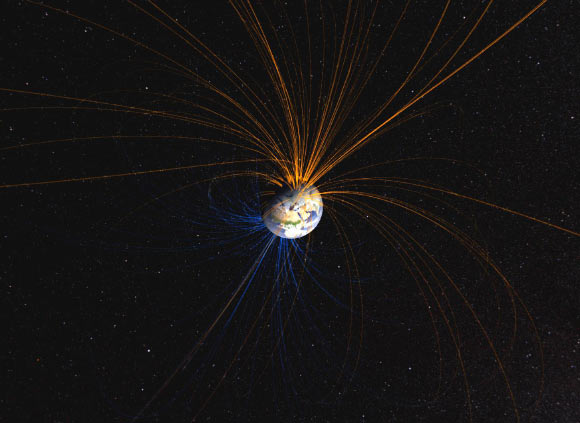Earth’s magnetic field is produced in the planet’s liquid iron outer core as it spins around the solid inner core, and protects the surface from harmful solar radiation. Its strength and structure have varied at different times throughout geological history. At certain periods, the field has weakened to such an extent that it was able to swap the positions of magnetic north and south, whilst geographic north and geographic south remain the same. Called a geomagnetic reversal, the last time this happened was 780,000 years ago. A new study led by the University of Wisconsin-Madison shows that this reversal took at least 22,000 years to complete. That’s several times longer than previously thought, and the results further call into question controversial findings that some reversals could occur within a human lifetime.

Earth’s magnetic field connects the North Pole (orange lines) with the South Pole (blue lines) in this NASA-created image. Image credit: NASA’s Goddard Space Flight Center.
“Reversals are generated in the deepest parts of the Earth’s interior, but the effects manifest themselves all the way through the Earth and especially at the Earth’s surface and in the atmosphere,” said lead author Dr. Brad Singer, a geologist at the University of Wisconsin-Madison.
“Unless you have a complete, accurate and high-resolution record of what a field reversal really is like at the surface of the Earth, it’s difficult to even discuss what the mechanics of generating a reversal are.”
For the study, Dr. Singer and his colleagues focused on lava flows from Chile, Tahiti, Hawaii, the Caribbean and the Canary Islands. They collected samples from these lava flows over several field seasons.
“Lava flows are ideal recorders of the magnetic field. They have a lot of iron-bearing minerals, and when they cool, they lock in the direction of the field,” he explained.
“But it’s a spotty record. No volcanoes are erupting continuously. So we’re relying on careful field work to identify the right records.”
The researchers combined magnetic readings and radioisotope dating of samples from seven lava flow sequences to recreate the magnetic field over a span of about 70,000 years centered on the latest geomagnetic reversal.
They accurately dated the lava flows by measuring the argon produced from radioactive decay of potassium in the rocks.
They found that the final reversal was quick by geological standards, less than 4,000 years.
But it was preceded by an extended period of instability that included two excursions — temporary, partial reversals — stretching back another 18,000 years.
That span is more than twice as long as suggested by recent proposals that all reversals wrap up within 9,000 years.
The lava flow data was corroborated by magnetic readings from the seafloor, which provides a more continuous but less precise source of data than lava rocks.
The scientists also used Antarctic ice cores to track the deposition of beryllium, which is produced by cosmic radiation colliding with the atmosphere.
When the magnetic field is reversing, it weakens and allows more radiation to strike the atmosphere, producing more beryllium.
Since humanity began recording the strength of the magnetic field, it has decreased in strength about 5% each century.
As records like these show, a weakening field seems to be a precursor to an eventual reversal, although it’s far from clear that a reversal is imminent.
“Now we have a richer record and better-dated record of this last reversal than ever before,” Dr. Singer said.
The findings were published in the journal Science Advances.
_____
Brad S. Singer et al. 2019. Synchronizing volcanic, sedimentary, and ice core records of Earth’s last magnetic polarity reversal. Science Advances 5 (8): eaaw4621; doi: 10.1126/sciadv.aaw4621







